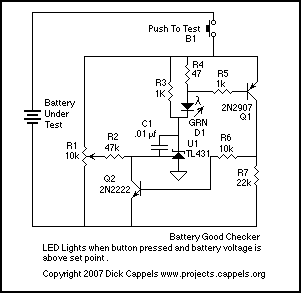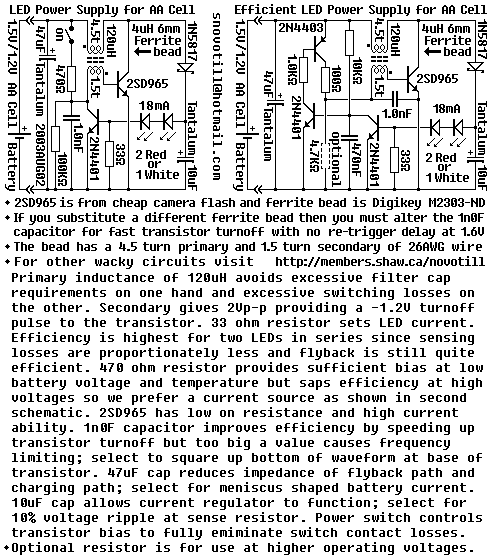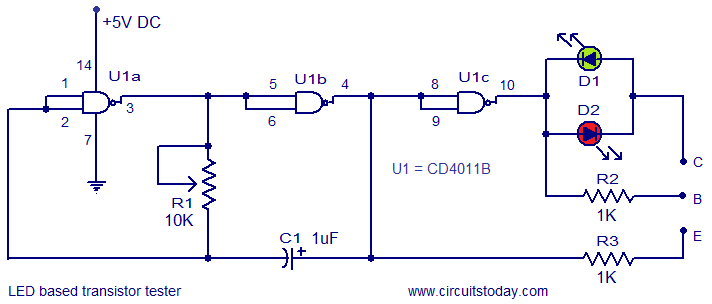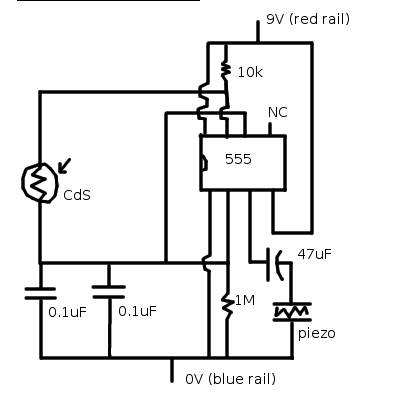
Pocket LED Light
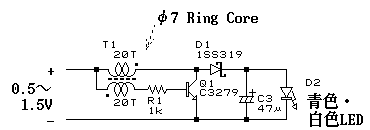
This is a pocket-sized LED flashlight operating with only one AAA battery. However, the super high luminosity LEDs (blue, green, or white) require at least 3.5 volts of forward voltage. This flashlight is boosting input voltage up to the operating voltage of an LED with a simple DC-DC converter. Right image shows the circuit diagram for the LED light. It is a typical blocking oscillator. High voltage pulse appears at the collector of the Q1 is rectified by D1 and charged into C3.
T1 is a hand-winded transformer. Please try to build the transformers to find the best condition; a drum core will be easy to build. Q1 is a low voltage strobe transistor; any other transistors may down efficiency. The output current can be adjusted by R1.
The circuit described operates as a compact LED flashlight powered by a single AAA battery, utilizing a DC-DC boost converter to elevate the voltage necessary for high-luminosity LEDs. The essential components include a blocking oscillator configuration that generates high-voltage pulses. In this setup, Q1 acts as the primary switching element, which is a low-voltage strobe transistor. Its role is critical as it modulates the current flow through the transformer, T1, which is custom-wound to optimize the inductive coupling and efficiency of the voltage boost.
The transformer, T1, is designed to step up the voltage from the AAA battery (typically 1.5V) to the required forward voltage for the LEDs. The winding technique and core material, such as a drum core, can significantly influence the performance, and experimentation with different configurations may yield better results in terms of efficiency and output voltage.
The output of the transformer is connected to a rectifier diode, D1, which converts the alternating current (AC) pulses generated by the transformer into direct current (DC) suitable for powering the LEDs. The rectified output is then stored in capacitor C3, smoothing out the voltage to provide a stable supply for the LEDs.
The adjustment of output current to the LEDs is facilitated by resistor R1. By varying the resistance, the brightness of the LEDs can be controlled, allowing for flexibility in operation depending on the desired light output and battery life considerations.
Overall, this circuit exemplifies a practical application of basic electronic components to achieve a functional and efficient portable lighting solution.This is a pocket-sized LED flashlight operating with only one AAA battery. However, the super high luminosity LEDs(blue,green or white) require at least 3.5 volts of forward voltage. This flashlight is boosting input voltage up to operating voltage of a LED with simple DC-DC converter.
Right image shows the circuit diagram for the LED light. It is a typical blocking oscilator. High voltage pulse appears at collector of the Q1 is rectified by D1 and charged into C3. T1 is a hand-winded transformer. Please try to build the transformers to find the best condition, a drum core will be easy to build. Q1 is a low voltage strobe transister, any other transisters may down effeciency. The output current can be adujusted by R1. 🔗 External reference
T1 is a hand-winded transformer. Please try to build the transformers to find the best condition; a drum core will be easy to build. Q1 is a low voltage strobe transistor; any other transistors may down efficiency. The output current can be adjusted by R1.
The circuit described operates as a compact LED flashlight powered by a single AAA battery, utilizing a DC-DC boost converter to elevate the voltage necessary for high-luminosity LEDs. The essential components include a blocking oscillator configuration that generates high-voltage pulses. In this setup, Q1 acts as the primary switching element, which is a low-voltage strobe transistor. Its role is critical as it modulates the current flow through the transformer, T1, which is custom-wound to optimize the inductive coupling and efficiency of the voltage boost.
The transformer, T1, is designed to step up the voltage from the AAA battery (typically 1.5V) to the required forward voltage for the LEDs. The winding technique and core material, such as a drum core, can significantly influence the performance, and experimentation with different configurations may yield better results in terms of efficiency and output voltage.
The output of the transformer is connected to a rectifier diode, D1, which converts the alternating current (AC) pulses generated by the transformer into direct current (DC) suitable for powering the LEDs. The rectified output is then stored in capacitor C3, smoothing out the voltage to provide a stable supply for the LEDs.
The adjustment of output current to the LEDs is facilitated by resistor R1. By varying the resistance, the brightness of the LEDs can be controlled, allowing for flexibility in operation depending on the desired light output and battery life considerations.
Overall, this circuit exemplifies a practical application of basic electronic components to achieve a functional and efficient portable lighting solution.This is a pocket-sized LED flashlight operating with only one AAA battery. However, the super high luminosity LEDs(blue,green or white) require at least 3.5 volts of forward voltage. This flashlight is boosting input voltage up to operating voltage of a LED with simple DC-DC converter.
Right image shows the circuit diagram for the LED light. It is a typical blocking oscilator. High voltage pulse appears at collector of the Q1 is rectified by D1 and charged into C3. T1 is a hand-winded transformer. Please try to build the transformers to find the best condition, a drum core will be easy to build. Q1 is a low voltage strobe transister, any other transisters may down effeciency. The output current can be adujusted by R1. 🔗 External reference

